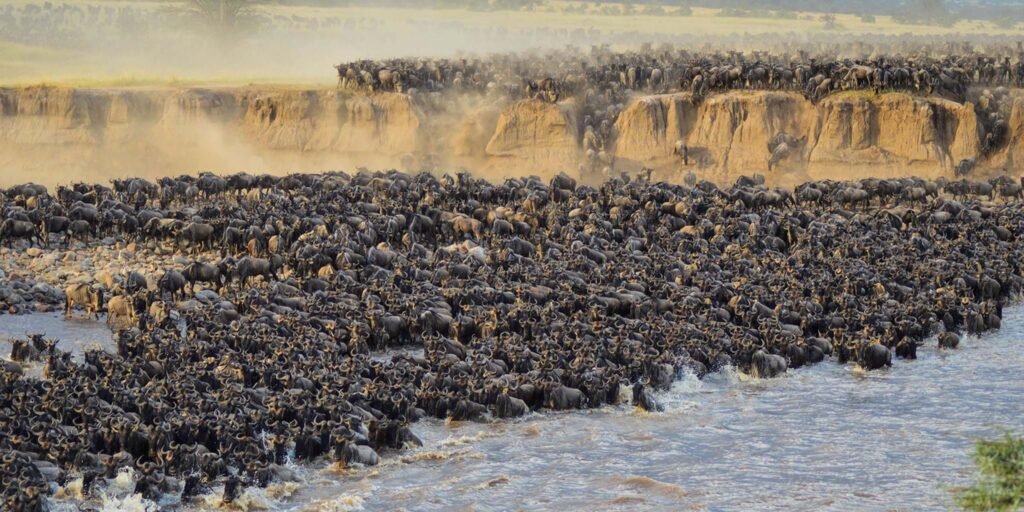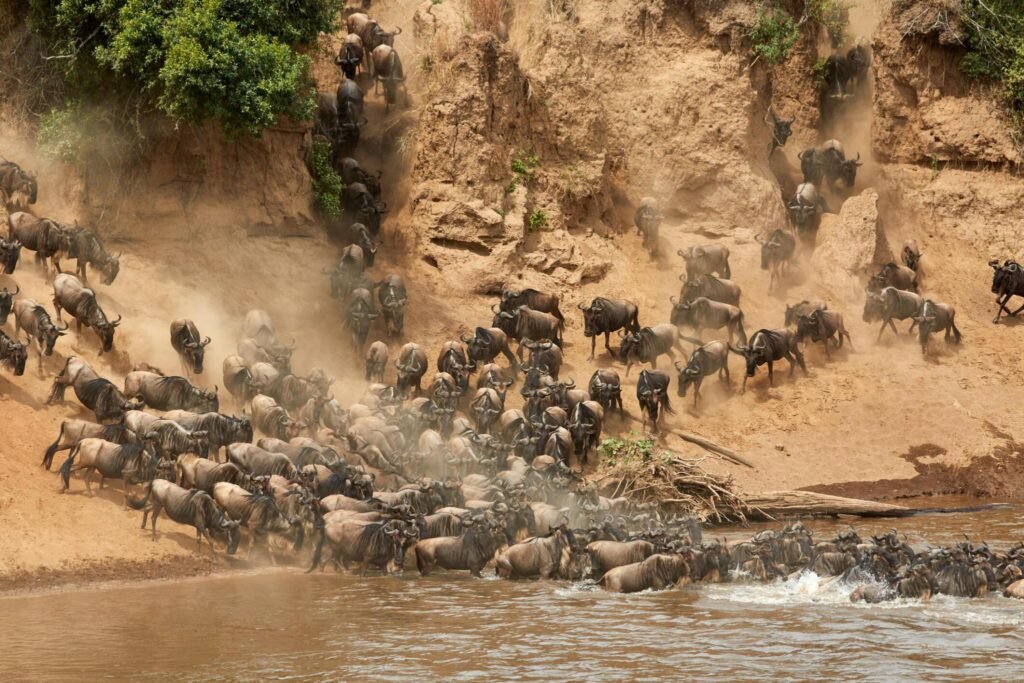Great Migration River Crossing 2025/2026 is one of the most dramatic wildlife events in the world. Every year, over a million wildebeest, zebras, and gazelles move across the Serengeti and Maasai Mara in search of greener pastures. The highlight of this journey is the perilous crossing of the Mara and Grumeti Rivers, where herds brave crocodile-filled waters. This article will guide you through the best times and places to witness the Great Migration river crossings and offer helpful tips for making the most of your experience.
Plan your Great Migration tour with expert guides.

Great Migration River Crossing 2025/2026 : What is the Great Migration River Crossing?
The Great Migration is the largest movement of land animals on Earth, with millions of wildebeest, zebras, and other herbivores making an annual journey across Tanzania and Kenya. The river crossings are the most famous part of this migration, where herds must traverse the Mara and Grumeti Rivers. These crossings are dangerous, as crocodiles lie in wait, and swift currents can sweep animals away.
- Rivers to Watch: The Mara River and Grumeti River are the key spots for witnessing these crossings.
- Key Challenge: Predators such as crocodiles and big cats add to the danger for the migrating herds.
Read more about the Great Migration and its importance.
Great Migration River Crossing 2025/2026 : Best Time to See the River Crossings
Timing is crucial if you want to witness the river crossings during the Great Migration. The crossings do not happen on a fixed schedule, as they depend on rainfall and the condition of the grasslands. However, the best time to catch this spectacle is between July and October, when herds are likely to cross the Mara River.
Mara River Crossing (July – October)
During this period, herds can be seen crossing the Mara River in northern Serengeti and into the Maasai Mara in Kenya. This is the most dramatic part of the migration, as the animals must brave crocodile-infested waters to reach the other side.
- Peak Crossing Time: Late July to early October.
- Location: Northern Serengeti, close to the Kenya-Tanzania border.
Find out more about the Mara River crossing and its seasonal patterns.
Great Migration River Crossing 2025/2026 : Grumeti River Crossings (June – July)
Before reaching the Mara River, the herds must cross the Grumeti River in the western Serengeti. While less famous than the Mara River crossing, it still provides an exciting opportunity to witness the migration up close. The river is typically calmer than the Mara, but it still presents challenges, including hungry crocodiles.
- Best Viewing Time: Late June to early July.
- Location: Western Serengeti near the Grumeti Reserve.
Discover more about the Grumeti River and its role in the Great Migration.
Great Migration River Crossing 2025/2026 : Where to Stay for the Best River Crossing Views
Choosing the right location for your safari can greatly enhance your chances of seeing a river crossing. Lodges and camps near the Mara River in the northern Serengeti or along the Grumeti River offer excellent access to key crossing points.
Northern Serengeti
For witnessing the Mara River crossing, staying in the northern Serengeti or the Maasai Mara is ideal. Camps and lodges in this area often position you close to the action, increasing your chances of seeing a crossing.
- Top Recommendations: Lamai Serengeti and Sayari Camp are highly recommended for their proximity to the Mara River.
Learn more about top lodges in the northern Serengeti.
Western Serengeti
If you want to catch the Grumeti River crossings, staying in the western corridor of the Serengeti is a great option. Many camps here offer both game drives and river crossings.
- Top Recommendations: Grumeti Serengeti Tented Camp is a popular choice for viewing the Grumeti River crossings.
Find out more about lodges in the western Serengeti.
Great Migration River Crossing 2025/2026 : What to Expect During the Crossing
Watching the river crossings can be unpredictable. The herds gather at the riverbanks, sometimes hesitating for hours before making the plunge. Once they do cross, it’s a chaotic and awe-inspiring sight. Predators like crocodiles often wait near the water’s edge, while lions and hyenas patrol the nearby grasslands.
- Crocodile Predation: Nile crocodiles can grow up to 18 feet long and are capable of taking down wildebeest, zebras, and gazelles during the crossing.
- Tense Waiting: Herds often hesitate before crossing, creating a tense build-up for onlookers.
Read more about wildlife behaviors during the Great Migration.
Great Migration River Crossing 2025/2026 : Photography Tips for Capturing the River Crossing
The Great Migration river crossing is one of the most challenging wildlife spectacles to photograph. The action happens quickly, and the lighting conditions can vary. Here are some tips for capturing stunning photos:
- Use a Fast Shutter Speed: The crossing happens quickly, so a fast shutter speed (at least 1/1000 sec) will help freeze the action.
- Telephoto Lens: A 400mm or longer telephoto lens will allow you to capture close-up shots of the animals from a distance.
- Shoot in Continuous Mode: Set your camera to continuous shooting mode to capture multiple frames as the action unfolds.
Learn more about photography tips for the Great Migration.
Great Migration River Crossing 2025/2026 : What to Pack for Your Migration Safari
Packing the right gear is essential for a comfortable and enjoyable safari experience. Since the river crossings occur in remote areas, make sure you’re prepared for varying weather conditions and long hours outdoors.
Essentials
- Binoculars: To get a closer view of the animals before and after the crossing.
- Camera Gear: A DSLR or mirrorless camera with a telephoto lens is ideal for capturing the action.
- Sunscreen and Hat: The African sun can be intense, even during the cooler months.
Get more tips on what to pack for a Serengeti safari.
Great Migration River Crossing 2025/2026 : Other Wildlife to See During the Great Migration
While the river crossings are the highlight of the migration, the Serengeti and Maasai Mara are home to a wide variety of wildlife. During your safari, you can expect to see lions, cheetahs, elephants, and giraffes in addition to the migrating herds.
- Predators: Watch for lions, cheetahs, and hyenas that follow the herds in search of prey.
- Birdlife: The Serengeti is home to over 500 species of birds, making it a paradise for bird watchers.
Explore the diverse wildlife in the Serengeti.
Great Migration River Crossing 2025/2026 : Best Viewing Points for River Crossings
There are several prime locations along the Mara and Grumeti Rivers to watch the crossings. Local guides are essential in positioning you at the right spot at the right time. Here are some of the best areas:
Mara River
- Crossing Points: Look for crossing points near Kogatende in the northern Serengeti, where animals often gather.
Grumeti River
- Top Spots: The crossing points along the Grumeti River in the western corridor offer excellent chances to see the migration.
Learn more about prime locations for the Great Migration.

Great Migration River Crossing 2025/2026 : How to Plan Your Great Migration Safari
Planning a Great Migration safari requires careful timing and coordination. Working with a reputable safari company ensures that you’ll be in the right place at the right time to witness the river crossings. Book well in advance, especially if you’re traveling during the peak season.
- Safari Duration: Plan for at least 5-7 days to increase your chances of seeing a crossing.
- Guided Tours: Opt for a guided tour that includes game drives in both the northern and western Serengeti.
Plan your perfect migration safari with trusted experts.
Great Migration River Crossing 2025/2026 : Conclusion
The Great Migration river crossing is one of nature’s most thrilling spectacles. Whether you’re watching the herds plunge into the Mara River or witnessing the quieter Grumeti crossings, the experience is unforgettable. With the right timing, location, and guidance, you can capture the drama of the migration and enjoy a once-in-a-lifetime safari in Tanzania.
For more information on booking a photo safari, visit Kilimanjaro Climb Specialist or Eddy Tours & Safaris.

